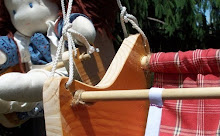Every day, several times a day, my little girl asks for a card to write a letter to someone she loves. We are working together to create her very own supply of cards, envelopes and all the fixings (which I am embarrassed to say really should have been done a long time ago). We are also exploring the history of paper, writing, and printing. Our first adventure with paper making went very well and we have big plans for further explorations. Stay tuned for a few Christmas project ideas made with your very own paper!
Our first paper making experiment was based on a decades old kit put together by Arnold Grummer’s . This kit was used many many times by my mother and little sister and we are so excited to give it another life in another generation. It is a very basic paper “recipe” and uses tin cans as a mold making wonderfully round little papers. Paper making is a very simple process which involves simple materials. Just my kind of thing! Here’s the process we followed. (I did scan Arnold’s directions as quick as I could amidst a steady peppering of questions from little mouths…yikes!..and then mostly went with common sense and bits and pieces I remembered from my own childhood papermaking)
Supplies:
These supplies came with the kit…but I will do my best to suggest alternatives.
Sources for paper making supplies: the Arnold Grummers site is easy to use and well stocked…have fun!
- Support screen (course plastic screen…plastic needle point canvas)
- Paper Making Screen (fine plastic screen…?!)
- Press Bar (piece of wood…any piece of wood ~8” x 8”)
- Water Removal Screen (floppy window screen…window screen scrap)
- Couch Sheets (6” x 6” white blotter sheets…coffee filters pressed very flat)
- Drain Rack (rigid grid…wire cooling rack)
- Two tin cans of equal size.
Blender, Rags, Liquids Measuring Cup, and paper
*********************************************************************
Now lets get started!
Step 1. Tear a 6”x 6” piece of any type of paper into small pieces and put them into a blender with 2 cups of water. Here’s the place to have lots of fun experimenting…try different papers and paper-like fibers. We like to use construction paper…but the skies the limit! Try adding, seeds, petals, herbs, etc.
(This makes one small “tin can paper”…the more you rip up the more paper you can make…just remember to adjust the water you add accordingly.)
Step 2. Put the lid on the onto the blender (!) and run it for 30 seconds. As the blender runs you are recycling the paper back into pulp that you will use to create your own unique paper.
Step 3. Place your (empty) tin can on a level surface, open end up.
Step 4. Place the support screen on top of the can. Place the white papermaking screen on top of the support screen.
Step 5. Cut off both ends of the second tin can. Place it on top of the papermaking screen so the rims of the cans match. (This is super tricky with little hands helping so have rags ready for any spills!)
Step 6. Pour the pulp from the blender into a smaller easier to handle container…like a liquid measuring cup. Pour the pulp into the can at a steady speed. Be careful not to bump the cans while the water drains into the second can.
Step 7. When all the water has drained through lift the top can straight up off the screen.
Yay…that floppy gooey thing is your new sheet of paper! Just a few more steps to get all that extra water out!
This is the step to add anything that you want to be on the surface of your paper…like a pressed flower.
Step 8. Carefully lift the papermaking screen with your new sheet off the can and lay it on a flat, clean surface. Lay the water removal screen over your new sheet.
Step 9. Take a sponge (or several layers of folded dish towel which is what we happened to have on hand!) and press it repeatedly down on the water removal screen to remove water. Wring out the sponge as necessary. Continue until no more water is removed.
Step 10. Carefully lift and peel off the water removal screen.
Step 11. Place a couch sheet over your new sheet. Turn over the sandwich you’ve made with couch sheet – new paper – papermaking screen…leaving the papermaking screen on top. Press the sponge down hard and repeatedly on the papermaking screen removing more water.
Step 12. Carefully lift and peel off the papermaking screen leaving your new paper on the couch sheet. Place a dry couch sheet on top of your new paper and using the press board press down firmly to remove water.
Step 13. Remove the top couch sheet and carefully peel your new sheet from the other couch sheet. Place your new sheet of paper between two dry couch sheets and press again if needed.
Don’t throw you wet couch sheet away. Use them – dry them – re-use them!
Step 20. Take your new paper from between the couch sheets and lay it on a clean flat surface.
Step 21. Final drying: Take a clothes iron and press carefully with the steam off.
There is so much room for exploration and discovery with this process. We have big plans for lots of experiments, projects, and gifts.






















